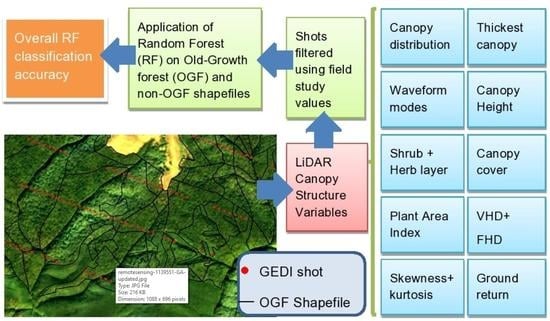Determination of Structural Characteristics of Old-Growth Forest in Ukraine Using Spaceborne LiDAR
Abstract
1. Introduction
- (1)
- OGF will differ significantly from reference managed forest stands (non-OGF, NOGF) on a number of vertical structure metrics. We expect OGF to have a more open canopy and to be structurally more complex.
- (2)
- The differences in structure between OGF and NOGF will permit the effective use of Random Forest classification to classify OGF and NOGF.
2. Material and Methods
2.1. Study Area
2.2. GEDI
2.3. GEDI Data Analysis Methods
2.4. Random Forest Classification
3. Results
3.1. Erroneous Measurements
3.1.1. Erroneous Canopy Height Measurements
3.1.2. Erroneous Ground Elevation Measurements
3.1.3. Erroneous Canopy Cover Measurements
3.1.4. GEDI Shot Removal
3.2. Forest Structure
3.2.1. Conifer Structure
3.2.2. Broadleaf Structure
3.3. Random Forest Classification
4. Discussion
5. Conclusions
Author Contributions
Funding
Institutional Review Board Statement
Informed Consent Statement
Data Availability Statement
Acknowledgments
Conflicts of Interest
References
- Sabatini, F.M.; Burrascano, S.; Keeton, W.S.; Levers, C.; Lindner, M.; Pötzschner, F.; Verkerk, P.J.; Bauhus, J.; Buchwald, E.; Chaskovsky, O.; et al. Where are europe’s last primary forests? Divers. Distrib. 2018, 24, 1426–1439. [Google Scholar] [CrossRef]
- Luyssaert, S.; Schulze, E.-D.; Börner, A.; Knohl, A.; Hessenmöller, D.; Law, B.E.; Ciais, P.; Grace, J. Old-growth forests as global carbon sinks. Nature 2008, 455, 213–215. [Google Scholar] [CrossRef]
- Paillet, Y.; Bergès, L.; Hjältén, J.; Ódor, P.; Avon, C.; Bernhardt-Römermann, M.; Bijlsma, R.-J.; De Bruyn, L.U.C.; Fuhr, M.; Grandin, U.L.F.; et al. Biodiversity differences between managed and unmanaged forests: Meta-analysis of species richness in Europe. Conserv. Biol. 2010, 24, 101–112. [Google Scholar] [CrossRef]
- Franklin, J.F.; Van Pelt, R. Spatial aspects of structural complexity in old-growth forests. J. For. 2004, 102, 22–28. [Google Scholar]
- Keren, S.; Diaci, J. Comparing the quantity and structure of deadwood in selection managed and old-growth forests in South-East Europe. Forests 2018, 9, 76. [Google Scholar] [CrossRef]
- Omar, H.; Misman, M.A.; Kassim, A.R. Synergetic of PALSAR-2 and Sentinel-1A SAR polarimetry for retrieving aboveground biomass in dipterocarp forest of Malaysia. Appl. Sci. 2017, 7, 675. [Google Scholar] [CrossRef]
- Lefsky, M.A.; Cohen, W.B.; Harding, D.J.; Parker, G.G.; Acker, S.A.; Gower, S.T. Lidar remote sensing of above-ground biomass in three biomes. Glob. Ecol. Biogeogr. 2002, 11, 393–399. [Google Scholar] [CrossRef]
- Goetz, S.; Steinberg, D.; Dubayah, R.; Blair, B. Laser remote sensing of canopy habitat heterogeneity as a predictor of bird species richness in an Eastern temperate forest, USA. Remote Sens. Environ. 2007, 108, 254–263. [Google Scholar] [CrossRef]
- Thomas, R.Q.; Hurtt, G.C.; Dubayah, R.; Schilz, M.H. Using lidar data and a height-structured ecosystem model to estimate forest carbon stocks and fluxes over mountainous terrain. Can. J. Remote Sens. 2008, 34, S351–S363. [Google Scholar] [CrossRef]
- Willim, K.; Stiers, M.; Annighöfer, P.; Ammer, C.; Ehbrecht, M.; Kabal, M.; Stillhard, J.; Seidel, D. Assessing understory complexity in beech-dominated forests (Fagus Sylvatica, L.) in Central Europe—From managed to primary forests. Sensors 2019, 19, 1684. [Google Scholar] [CrossRef]
- Stiers, M.; Annighöfer, P.; Seidel, D.; Willim, K.; Neudam, L.; Ammer, C. Quantifying the target state of forest stands managed with the continuous cover approach–Revisiting Möller’s “Dauerwald” concept after 100 years. Trees For. People 2020, 1, 100004. [Google Scholar] [CrossRef]
- Stiers, M.; Willim, K.; Seidel, D.; Ehbrecht, M.; Kabal, M.; Ammer, C.; Annighöfer, P. A Quantitative comparison of the structural complexity of managed, lately unmanaged and primary European beech (Fagus Sylvatica, L.) forests. For. Ecol. Manag. 2018, 430, 357–365. [Google Scholar] [CrossRef]
- Willim, K.; Stiers, M.; Annighöfer, P.; Ehbrecht, M.; Ammer, C.; Seidel, D. Spatial patterns of structural complexity in differently managed and unmanaged beech-dominated forests in Central Europe. Remote Sens. 2020, 12, 1907. [Google Scholar] [CrossRef]
- Kane, V.R.; Bakker, J.D.; McGaughey, R.J.; Lutz, J.A.; Gersonde, R.F.; Franklin, J.F. Examining conifer canopy structural complexity across forest ages and elevations with LiDAR data. Can. J. For. Res. 2010, 40, 774–787. [Google Scholar] [CrossRef]
- Kane, V.R.; McGaughey, R.J.; Bakker, J.D.; Gersonde, R.F.; Lutz, J.A.; Franklin, J.F. Comparisons between field-and LiDAR-based measures of stand structural complexity. Can. J. For. Res. 2010, 40, 761–773. [Google Scholar] [CrossRef]
- Lefsky, M.A.; Cohen, W.B.; Acker, S.A.; Parker, G.G.; Spies, T.A.; Harding, D. LiDAR remote sensing of the canopy structure and biophysical properties of Douglas-Fir Western Hemlock forests. Remote Sens. Environ. 1999, 70, 339–361. [Google Scholar] [CrossRef]
- Zimble, D.A.; Evans, D.L.; Carlson, G.C.; Parker, R.C.; Grado, S.C.; Gerard, P.D. Characterizing vertical forest structure using small-footprint airborne LiDAR. Remote Sens. Environ. 2003, 87, 171–182. [Google Scholar] [CrossRef]
- Coops, N.C.; Hilker, T.; Wulder, M.A.; St-Onge, B.; Newnham, G.; Siggins, A.; Trofymow, J.T. Estimating canopy structure of Douglas-Fir forest stands from discrete-return LiDAR. Trees 2007, 21, 295. [Google Scholar] [CrossRef]
- Wing, B.M.; Ritchie, M.W.; Boston, K.; Cohen, W.B.; Gitelman, A.; Olsen, M.J. Prediction of understory vegetation cover with airborne LiDAR in an interior ponderosa pine forest. Remote Sens. Environ. 2012, 124, 730–741. [Google Scholar] [CrossRef]
- Martinuzzi, S.; Vierling, L.A.; Gould, W.A.; Falkowski, M.J.; Evans, J.S.; Hudak, A.T.; Vierling, K.T. Mapping snags and understory shrubs for a LiDAR-based assessment of wildlife habitat suitability. Remote Sens. Environ. 2009, 113, 2533–2546. [Google Scholar] [CrossRef]
- Falkowski, M.J.; Evans, J.S.; Martinuzzi, S.; Gessler, P.E.; Hudak, A.T. Characterizing forest succession with LiDAR data: An evaluation for the Inland Northwest, USA. Remote Sens. Environ. 2009, 113, 946–956. [Google Scholar] [CrossRef]
- De Assis Barros, L. Assessing Set Aside Old-Growth Forests with Airborne LiDAR Metrics. Available online: https://chinookcomfor.ca/wp-content/uploads/2020/07/1st_Manuscript_Barros_20_09_2019.pdf (accessed on 2 January 2021).
- Popescu, S.C.; Zhao, K.; Neuenschwander, A.; Lin, C. Satellite LiDAR vs. small footprint airborne LiDAR: Comparing the accuracy of aboveground biomass estimates and forest structure metrics at footprint level. Remote Sens. Environ. 2011, 115, 2786–2797. [Google Scholar] [CrossRef]
- Schutz, B.E.; Zwally, H.J.; Shuman, C.A.; Hancock, D.; DiMarzio, J.P. Overview of the ICESat mission. Geophys. Res. Lett. 2005, 32, 1–4. [Google Scholar] [CrossRef]
- Lefsky, M.A. A global forest canopy height map from the moderate resolution imaging spectroradiometer and the geoscience laser altimeter system. Geophys. Res. Lett. 2010, 37. [Google Scholar] [CrossRef]
- Simard, M.; Pinto, N.; Fisher, J.B.; Baccini, A. Mapping forest canopy height globally with spaceborne LiDAR. J. Geophys. Res. Bio Geosci. 2011, 116, 4021. [Google Scholar] [CrossRef]
- Saatchi, S.S.; Harris, N.L.; Brown, S.; Lefsky, M.; Mitchard, E.T.; Salas, W.; Zutta, B.R.; Buermann, W.; Lewis, S.L.; Hagen, S. Benchmark map of forest carbon stocks in tropical regions across three continents. Proc. Natl. Acad. Sci. USA 2011, 108, 9899–9904. [Google Scholar] [CrossRef] [PubMed]
- Dubayah, R.; Blair, J.B.; Goetz, S.; Fatoyinbo, L.; Hansen, M.; Healey, S.; Hofton, M.; Hurtt, G.; Kellner, J.; Luthcke, S. The global ecosystem dynamics investigation: High-resolution laser ranging of the Earth’s forests and topography. Sci. Remote Sens. 2020, 1, 100002. [Google Scholar] [CrossRef]
- Vološčuk, I. Joint Slovak-Ukraine-Germany beech ecosystems as the world natural heritage. Ekológia (Bratislava) 2014, 33, 286–300. [Google Scholar] [CrossRef][Green Version]
- Dargavel, J. Inventory of the largest primeval beech forest in Europe: A Swiss-Ukrainian scientific adventure. Aus. For. 2014, 77, 212–213. [Google Scholar] [CrossRef]
- Volosyanchuk, R.; Prots, B.; Kagalo, A.; Shparyk, Y.; Cherniavskyi, M.; Bondaruk, G. Criteria and Methology for Virgin and Old-Growth (Quasi-Virgin) Forest Identification. Available online: http://d2ouvy59p0dg6k.cloudfront.net/downloads/old_growth_forest_identification_methodology.pdf. (accessed on 1 February 2021). (In Ukrainian).
- Tsaryk, I.; Didukh, Y.P.; Tasenkevich, L.; Waldon, B.; Boratynski, A. Pinus Mugo Turra (Pinaceae) in the Ukrainian Carpathians. Dendrobiology 2006, 55, 39–49. [Google Scholar]
- Spracklen, B.D.; Spracklen, D.V. Old-growth forest disturbance in the Ukrainian Carpathians. Forests 2020, 11, 151. [Google Scholar] [CrossRef]
- Keeton, W.S.; Angelstam, P.K.; Bihun, Y.; Chernyavskyy, M.; Crow, S.M.; Deyneka, A.; Elbakidze, M.; Farley, J.; Kovalyshyn, V.; Kruhlov, I.; et al. Sustainable forest management alternatives for the Carpathian Mountains with a focus on Ukraine. In The Carpathians: Integrating Nature and Society Towards Sustainability; Kozak, J., Katarzyna, O., Bytnerowicz, A., Wyżga, B., Eds.; Springer: Berlin/Heidelberg, Germany, 2013; pp. 331–352. [Google Scholar]
- Krynytskyi, H.T.; Chernyavskyi, M.V.; Krynytska, O.H.; Deineka, A.M.; Kolisnyk, B.I.; Tselen, Y.P. Close-to-nature forestry as the basis for sustainable forest management in Ukraine. Sci. Bull. UNFU 2017, 27, 26–31. [Google Scholar] [CrossRef]
- Adam, M.; Urbazaev, M.; Dubois, C.; Schmullius, C. Accuracy assessment of GEDI terrain elevation and canopy height estimates in European temperate forests: Influence of environmental and acquisition parameters. Remote Sens. 2020, 12, 3948. [Google Scholar] [CrossRef]
- Gdulová, K.; Marešová, J.; Moudrỳ, V. Accuracy assessment of the global TanDEM-X digital elevation model in a mountain environment. Remote Sens. Environ. 2020, 241, 111724. [Google Scholar] [CrossRef]
- Uuemaa, E.; Ahi, S.; Montibeller, B.; Muru, M.; Kmoch, A. Vertical accuracy of freely available global digital elevation models (ASTER, AW3D30, MERIT, TanDEM-X., SRTM, and NASADEM). Remote Sens. 2020, 12, 3482. [Google Scholar] [CrossRef]
- Rugani, T.; Diaci, J.; Hladnik, D. Gap dynamics and structure of two old-growth beech forest remnants in Slovenia. PLoS ONE 2013, 8, e52641. [Google Scholar] [CrossRef]
- Parpan, T.V.; Parpan, V.I. Ecological Structure of beech and coniferous/beech mountain climax forest stands of Ukrainian Carpathians. Sci. Bull. UNFU 2017, 27, 59–63. [Google Scholar] [CrossRef][Green Version]
- Breiman, L. Random forests. Mach. Learn. 2001, 45, 5–32. [Google Scholar] [CrossRef]
- Dalponte, M.; Bruzzone, L.; Gianelle, D. Tree species classification in the Southern Alps based on the fusion of very high geometrical resolution multispectral/hyperspectral images and LiDAR data. Remote Sens. Environ. 2012, 123, 258–270. [Google Scholar] [CrossRef]
- Shi, Y.; Wang, T.; Skidmore, A.K.; Heurich, M. Important LiDAR metrics for discriminating forest tree species in Central Europe. ISPRS J. Photogramm. Remote Sens. 2018, 137, 163–174. [Google Scholar] [CrossRef]
- Fedrigo, M.; Newnham, G.J.; Coops, N.C.; Culvenor, D.S.; Bolton, D.K.; Nitschke, C.R. Predicting temperate forest stand types using only structural profiles from discrete return airborne LiDAR. ISPRS J. Photogramm. Remote Sens. 2018, 136, 106–119. [Google Scholar] [CrossRef]
- Penner, M.; Pitt, D.G.; Woods, M.E. Parametric vs. nonparametric LiDAR models for operational forest inventory in Boreal Ontario. Can. J. Remote Sens. 2013, 39, 426–443. [Google Scholar]
- Shen, X.; Cao, L. Tree-species classification in subtropical forests using airborne hyperspectral and LiDAR data. Remote Sens. 2017, 9, 1180. [Google Scholar] [CrossRef]
- Venier, L.A.; Swystun, T.; Mazerolle, M.J.; Kreutzweiser, D.P.; Wainio-Keizer, K.L.; McIlwrick, K.A.; Woods, M.E.; Wang, X. Modelling vegetation understory cover using LiDAR metrics. PLoS ONE 2019, 14, e0220096. [Google Scholar] [CrossRef] [PubMed]
- Fayad, I.; Baghdadi, N.; Bailly, J.-S.; Barbier, N.; Gond, V.; Hajj, M.E.; Fabre, F.; Bourgine, B. Canopy height estimation in French Guiana with LiDAR ICESat/GLAS data using principal component analysis and random forest regressions. Remote Sens. 2014, 6, 11883–11914. [Google Scholar] [CrossRef]
- Su, Y.; Ma, Q.; Guo, Q. Fine-resolution forest tree height estimation across the Sierra Nevada through the integration of spaceborne LiDAR, airborne LiDAR, and optical imagery. Int. J. Digit. Earth 2017, 10, 307–323. [Google Scholar] [CrossRef]
- Wang, M.; Sun, R.; Xiao, Z. Estimation of forest canopy height and aboveground biomass from spaceborne LiDAR and landsat imageries in Maryland. Remote Sens. 2018, 10, 344. [Google Scholar] [CrossRef]
- Spracklen, B.D.; Spracklen, D.V. Identifying European old-growth forests using remote sensing: A study in the Ukrainian Carpathians. Forests 2019, 10, 127. [Google Scholar] [CrossRef]
- Pedregosa, F.; Varoquaux, G.; Gramfort, A.; Michel, V.; Thirion, B.; Grisel, O.; Blondel, M.; Prettenhofer, P.; Weiss, R.; Dubourg, V. Scikit-learn: Machine learning in Python. J. Mach. Learn. Res. 2011, 12, 2825–2830. [Google Scholar]
- Lachin, J.M. Introduction to sample size determination and power analysis for clinical trials. Control. Clin. Trials 1981, 2, 93–113. [Google Scholar] [CrossRef]
- Maycock, P.E.; Guzik, J.; Jankovic, J.; Shevera, M.; Carleton, T.J. Composition, structure and ecological aspects of mesic old growth Carpathian Deciduous forests of Slovakia, Southern Poland and the Western Ukraine. Fragm. Florist. Geobot. 2000, 45, 281–321. [Google Scholar]
- Commarmot, B.; Bachofen, H.; Bundziak, Y.; Bürgi, A.; Ramp, B.; Shparyk, Y.; Sukhariuk, D.; Viter, R.; Zingg, A. Structures of virgin and managed beech forests in Uholka (Ukraine) and Sihlwald (Switzerland): A comparative study. For. Snow Landsc. Res. 2005, 79, 45–56. [Google Scholar]
- Matović, B.; Koprivica, M.; Kisin, B.; Stojanović, D.; Kneginjić, I.; Stjepanović, S. Comparison of stand structure in managed and virgin European beech forests in Serbia. Šumarski List 2018, 142, 47–57. [Google Scholar] [CrossRef]
- Turcu, D.-O.; Stetca, I.A. The structure and dynamics of virgin beech forest ecosystems from “Izvoarele Nerei” reserve–initial results. In Proceedings of the IUFRO 1.01.07 Ecology and Silviculture of Beech—Symposium, Lviv, Ukraine, 2–4 September 2019. [Google Scholar]
- Bilek, L.; Remes, J.; Zahradnik, D. Managed vs. unmanaged. structure of beech forest stands (Fagus Sylvatica, L.) after 50 years of development, Central Bohemia. For. Syst. 2011, 20, 122–138. [Google Scholar] [CrossRef]
- Holeksa, J.; Saniga, M.; Szwagrzyk, J.; Czerniak, M.; Staszyńska, K.; Kapusta, P. A giant tree stand in the west Carpathians—An exception or a relic of formerly widespread mountain European forests? For. Ecol. Manag. 2009, 257, 1577–1585. [Google Scholar] [CrossRef]
- Keeton, W.S.; Chernyavskyy, M.; Gratzer, G.; Main-Knorn, M.; Shpylchak, M.; Bihun, Y. Structural characteristics and aboveground biomass of old-growth spruce–fir stands in the eastern Carpathian Mountains, Ukraine. Plant Biosyst. 2010, 144, 148–159. [Google Scholar] [CrossRef]
- Farr, T.G.; Kobrick, M. Shuttle radar topography mission produces a wealth of data. Eos 2000, 81, 583–585. [Google Scholar] [CrossRef]
- Nadyeina, O.; Dymytrova, L.; Naumovych, A.; Postoyalkin, S.; Scheidegger, C. Distribution and dispersal ecology of Lobaria Pulmonaria in the largest primeval beech forest of Europe. Biodivers. Conserv. 2014, 23, 3241–3262. [Google Scholar] [CrossRef]
- Popa, I.; Nechita, C.; Hofgaard, A. Stand structure, recruitment and growth dynamics in mixed subalpine spruce and Swiss stone pine forests in the Eastern Carpathians. Sci. Total Environ. 2017, 598, 1050–1057. [Google Scholar] [CrossRef] [PubMed]
- Lamedica, S.; Lingua, E.; Popa, I.; Motta, R.; Carrer, M. Spatial structure in four Norway spruce stands with different management history in the Alps and Carpathians. Silva Fenn. 2011, 45, 865–873. [Google Scholar] [CrossRef]
- Jaworski, A.; Kolodziej, Z.B.; Porada, K. Structure and dynamics of stands of primeval character in selected areas of the Bieszczady National Park. J. For. Sci. 2002, 48, 185–201. [Google Scholar] [CrossRef]
- Dong, L.; Tang, S.; Min, M.; Veroustraete, F. Estimation of forest canopy height in hilly areas using LiDAR waveform data. IEEE J. Sel. Top. Appl. Earth Obs. Remote Sens. 2019, 12, 1559–1571. [Google Scholar] [CrossRef]
- Hilbert, C.; Schmullius, C. Influence of surface topography on ICESat/GLAS forest height estimation and waveform shape. Remote Sens. 2012, 4, 2210–2235. [Google Scholar] [CrossRef]
- Sun, G.; Ranson, K.J.; Kimes, D.S.; Blair, J.B.; Kovacs, K. Forest vertical structure from GLAS: An evaluation using LVIS and SRTM data. Remote Sens. Environ. 2008, 112, 107–117. [Google Scholar] [CrossRef]
- Heurich, M.; Thoma, F. Estimation of forestry stand parameters using laser scanning data in temperate, structurally rich natural European beech (Fagus Sylvatica) and Norway spruce (Picea Abies) Forests. Forestry 2008, 81, 645–661. [Google Scholar] [CrossRef]
- Enßle, F.; Heinzel, J.; Koch, B. Accuracy of vegetation height and terrain elevation derived from ICESat/GLAS in forested areas. Int. J. Appl. Earth Obs. Geoinf. 2014, 31, 37–44. [Google Scholar] [CrossRef]
- Wang, C.; Zhu, X.; Nie, S.; Xi, X.; Li, D.; Zheng, W.; Chen, S. Ground elevation accuracy verification of ICESat-2 data: A case study in Alaska, USA. Opt. Express 2019, 27, 38168–38179. [Google Scholar] [CrossRef] [PubMed]
- Hyyppä, H.; Yu, X.; Hyyppä, J.; Kaartinen, H.; Kaasalainen, S.; Honkavaara, E.; Rönnholm, P. Factors affecting the quality of DTM generation in forested areas. Int. Arch. Photogramm. Remote Sens. Spat. Inf. Sci. 2005, 36, 85–90. [Google Scholar]
- Hodgson, M.E.; Jensen, J.R.; Schmidt, L.; Schill, S.; Davis, B. An evaluation of LIDAR-and IFSAR-derived digital elevation models in leaf-on conditions with USGS level 1 and level 2 DEMs. Remote Sens. Environ. 2003, 84, 295–308. [Google Scholar] [CrossRef]
- Los, S.O.; Rosette, J.A.; Kljun, N.; North, P.R.J.; Chasmer, L.; Suárez, J.C.; Hopkinson, C.; Hill, R.A.; van Gorsel, E.; Mahoney, C. Vegetation height and cover fraction between 60 s and 60 n from ICESat GLAS data. Geosci. Model Dev. 2012, 5, 413–432. [Google Scholar] [CrossRef]
- Ferlin, F. The growth potential of understorey silver fir and Norway spruce for uneven-aged forest management in Slovenia. Forestry 2002, 75, 375–383. [Google Scholar] [CrossRef]
- Petritan, A.M.; Von Lüpke, B.; Petritan, I.C. Effects of shade on growth and mortality of maple (Acer Pseudoplatanus), ash (Fraxinus Excelsior) and beech (Fagus Sylvatica) saplings. Forestry 2007, 80, 397–412. [Google Scholar] [CrossRef]
- Svoboda, M.; Fraver, S.; Janda, P.; Bače, R.; Zenáhlíková, J. Natural development and regeneration of a Central European montane spruce forest. For. Ecol. Manag. 2010, 260, 707–714. [Google Scholar] [CrossRef]
- Zhuang, W.; Mountrakis, G. Ground peak identification in dense shrub areas using large footprint waveform LiDAR and landsat images. Int. J. Digit. Earth 2015, 8, 805–824. [Google Scholar] [CrossRef]
- Ilangakoon, G.Y.M.N.T. Complexity and Dynamics of Semi-Arid Vegetation Structure, Function and Diversity Across Spatial Scales from Full Waveform LiDAR. Ph.D. Thesis, Boise State University, Boise, ID, USA, 2020. [Google Scholar]
- Drössler, L.; Von Lüpke, B. Canopy gaps in two virgin beech forest reserves in Slovakia. J. For. Sci. 2005, 51, 446–457. [Google Scholar] [CrossRef]
- Feldmann, E.; Drößler, L.; Hauck, M.; Kucbel, S.; Pichler, V.; Leuschner, C. Canopy gap dynamics and tree understory release in a virgin beech forest, Slovakian Carpathians. For. Ecol. Manag. 2018, 415, 38–46. [Google Scholar] [CrossRef]
- Hobi, M.L.; Ginzler, C.; Commarmot, B.; Bugmann, H. Gap pattern of the largest primeval beech forest of Europe revealed by Remote Sensing. Ecosphere 2015, 6, 1–15. [Google Scholar] [CrossRef]
- Kucbel, S.; Jaloviar, P.; Saniga, M.; Vencurik, J.; Klimaš, V. Canopy gaps in an old-growth fir-beech forest remnant of Western Carpathians. Eur. J. For. Res. 2010, 129, 249–259. [Google Scholar] [CrossRef]
- Parobeková, Z.; Pittner, J.; Kucbel, S.; Saniga, M.; Filípek, M.; Sedmáková, D.; Vencurik, J.; Jaloviar, P. Structural diversity in a mixed spruce-fir-beech old-growth forest remnant of the Western Carpathians. Forests 2018, 9, 379. [Google Scholar] [CrossRef]
- Kenderes, K.; Král, K.; Vrška, T.; Standovár, T. Natural gap dynamics in a Central European mixed beech—spruce—fir old-growth forest. Ecoscience 2009, 16, 39–47. [Google Scholar] [CrossRef]
- Kati, V.; Dimopoulos, P.; Papaioannou, H.; Poirazidis, K. Ecological management of a mediterranean mountainous reserve (Pindos National Park, Greece) using the bird community as an indicator. J. Nat. Conserv. 2009, 17, 47–59. [Google Scholar] [CrossRef]
- Schooler, S.L.; Zald, H.S. LiDAR prediction of small mammal diversity in Wisconsin, USA. Remote Sens. 2019, 11, 2222. [Google Scholar] [CrossRef]
- Atchley, A.L.; Linn, R.; Jonko, A.; Hoffman, C.; Hyman, J.D.; Pimont, F.; Sieg, C.; Middleton, R.S. Effects of fuel spatial distribution on wildland fire behaviour. Int. J. Wildland Fire 2021, 30, 179–189. [Google Scholar] [CrossRef]
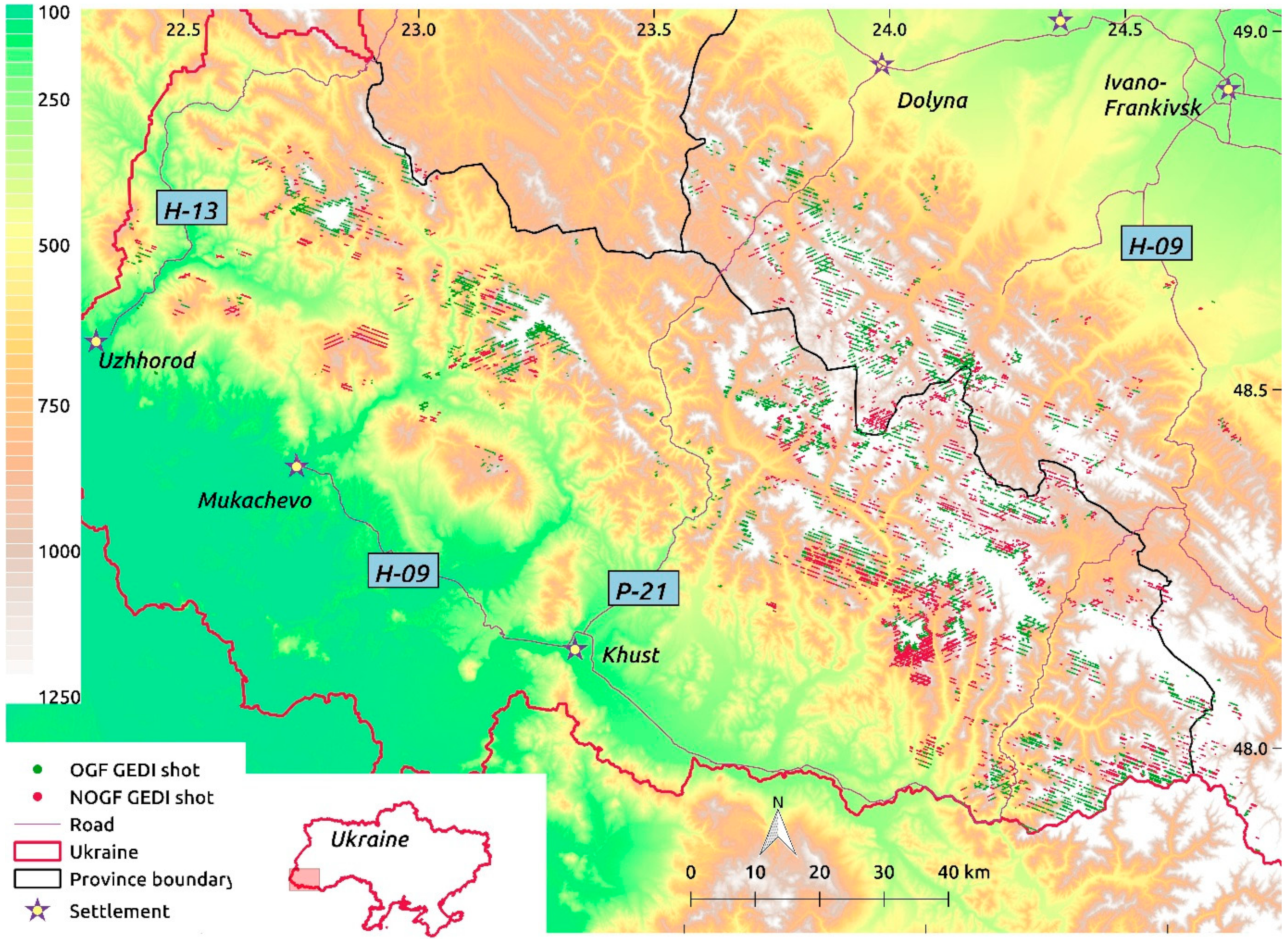
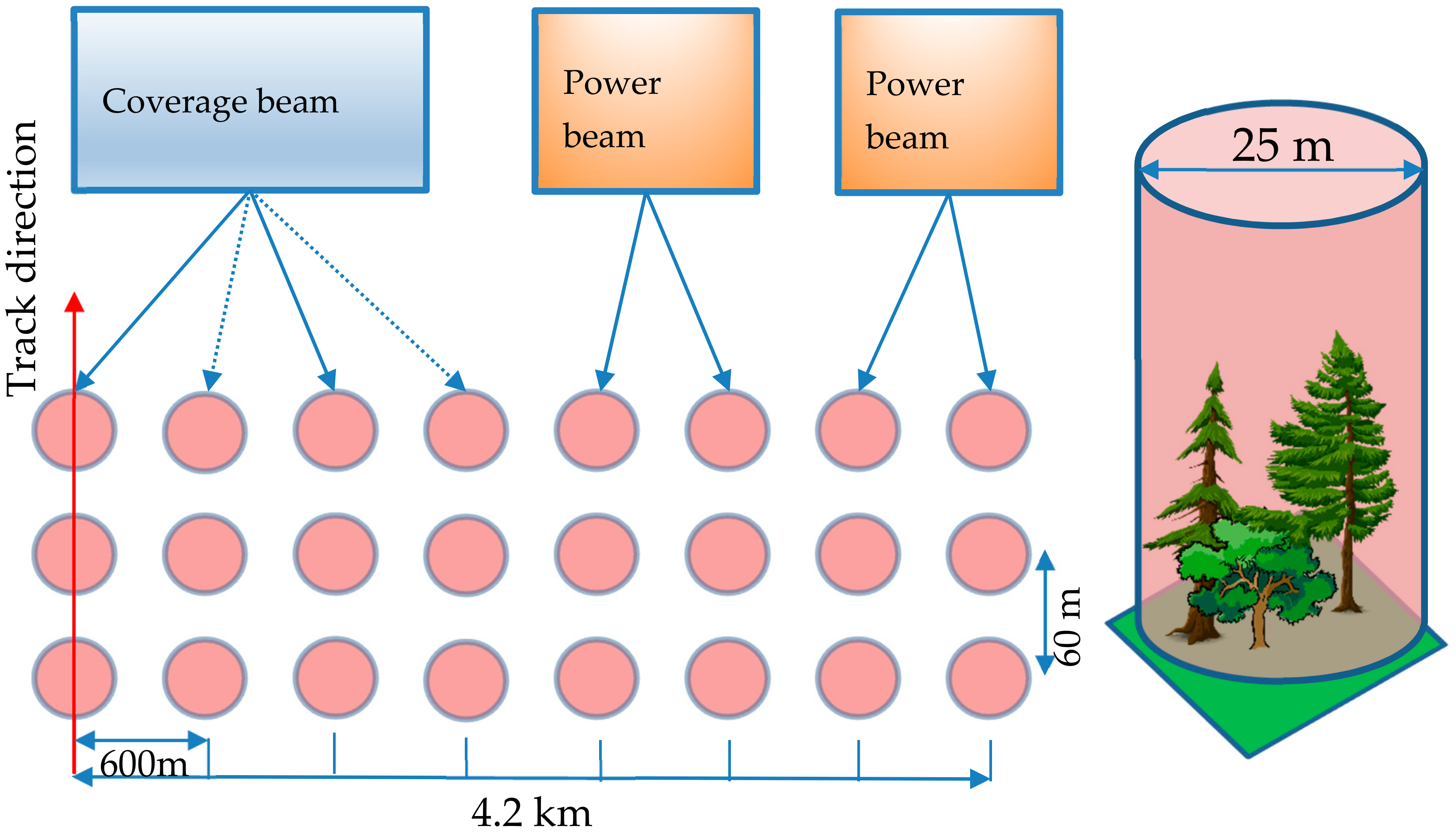




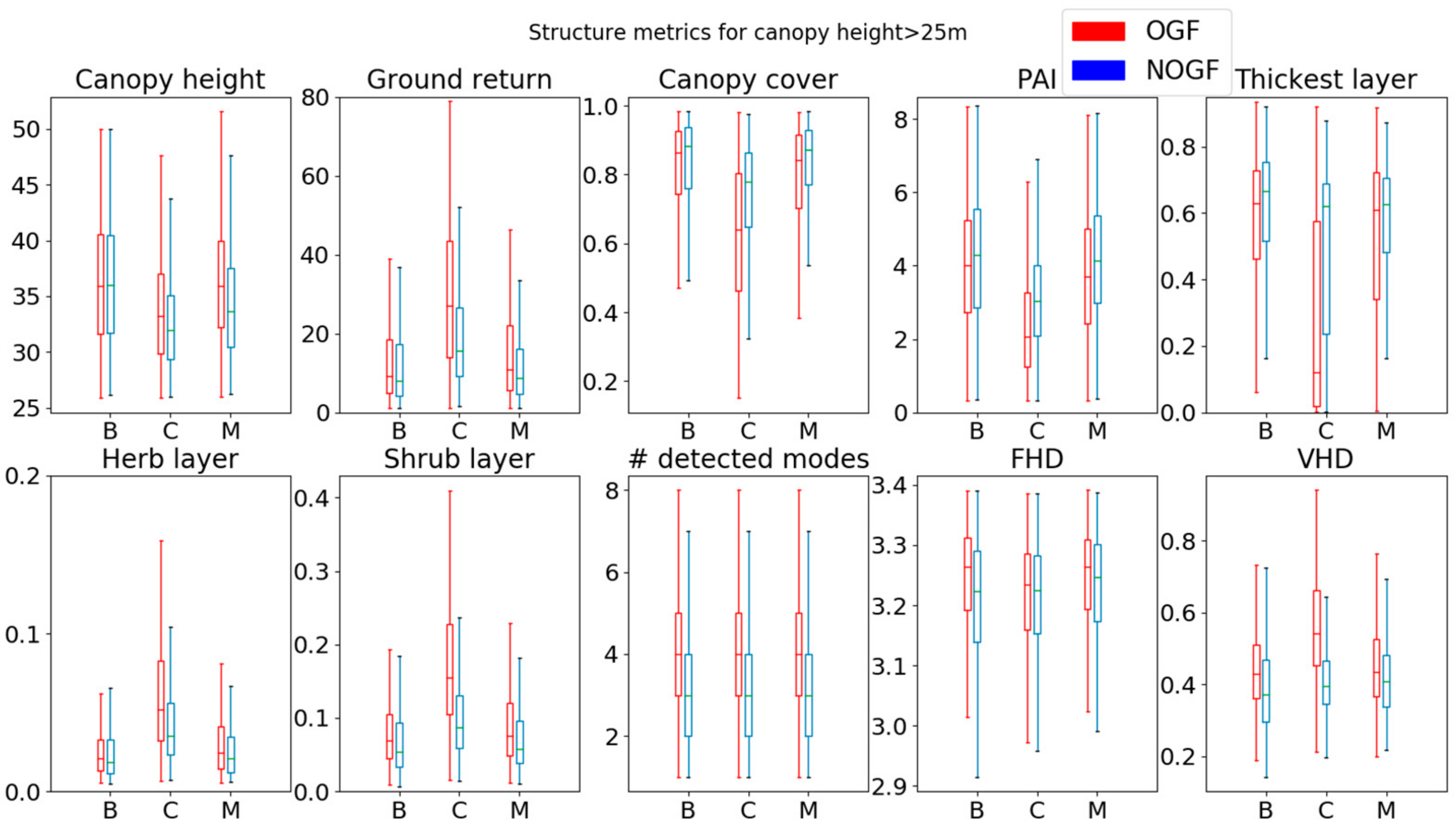
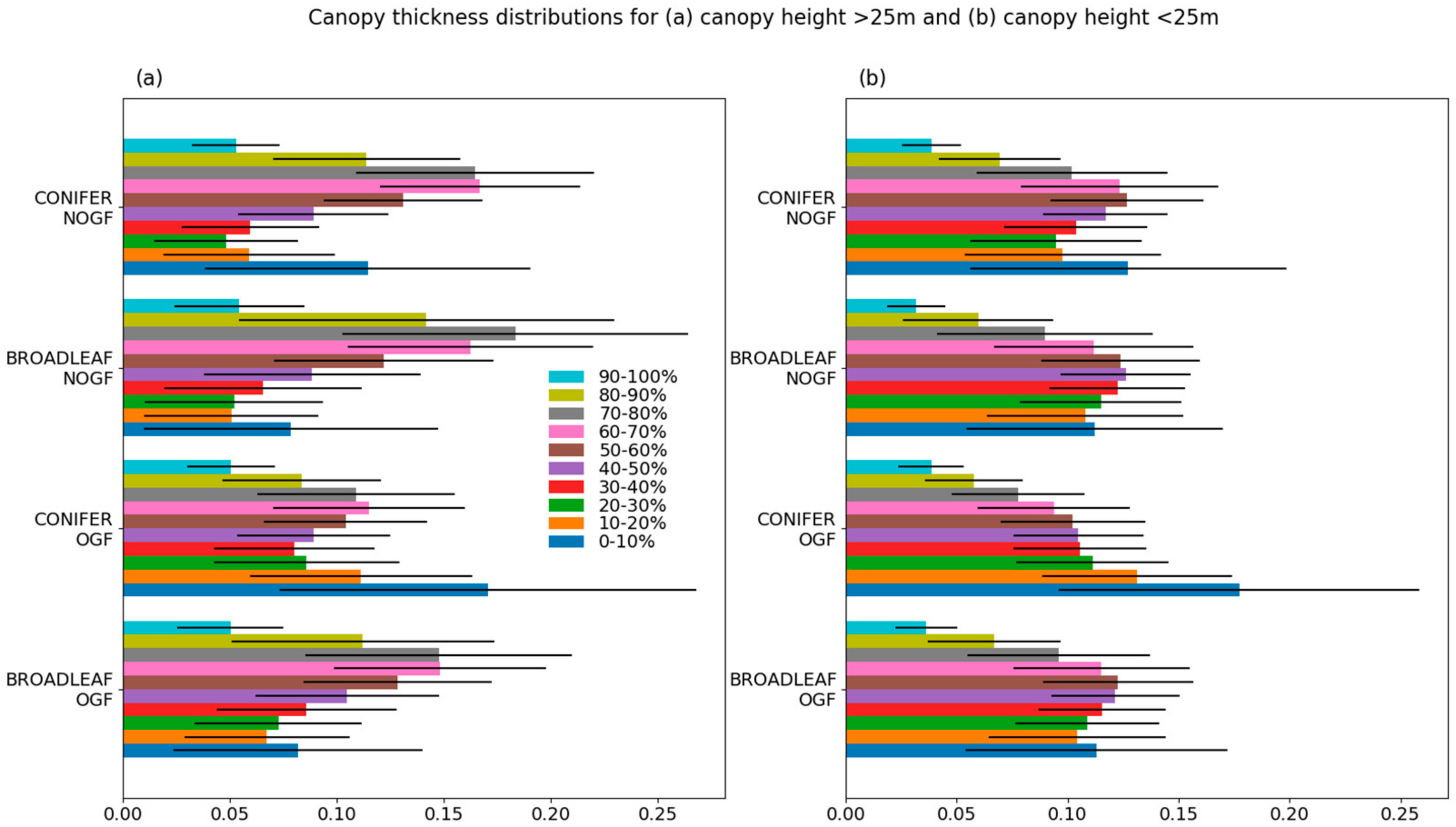
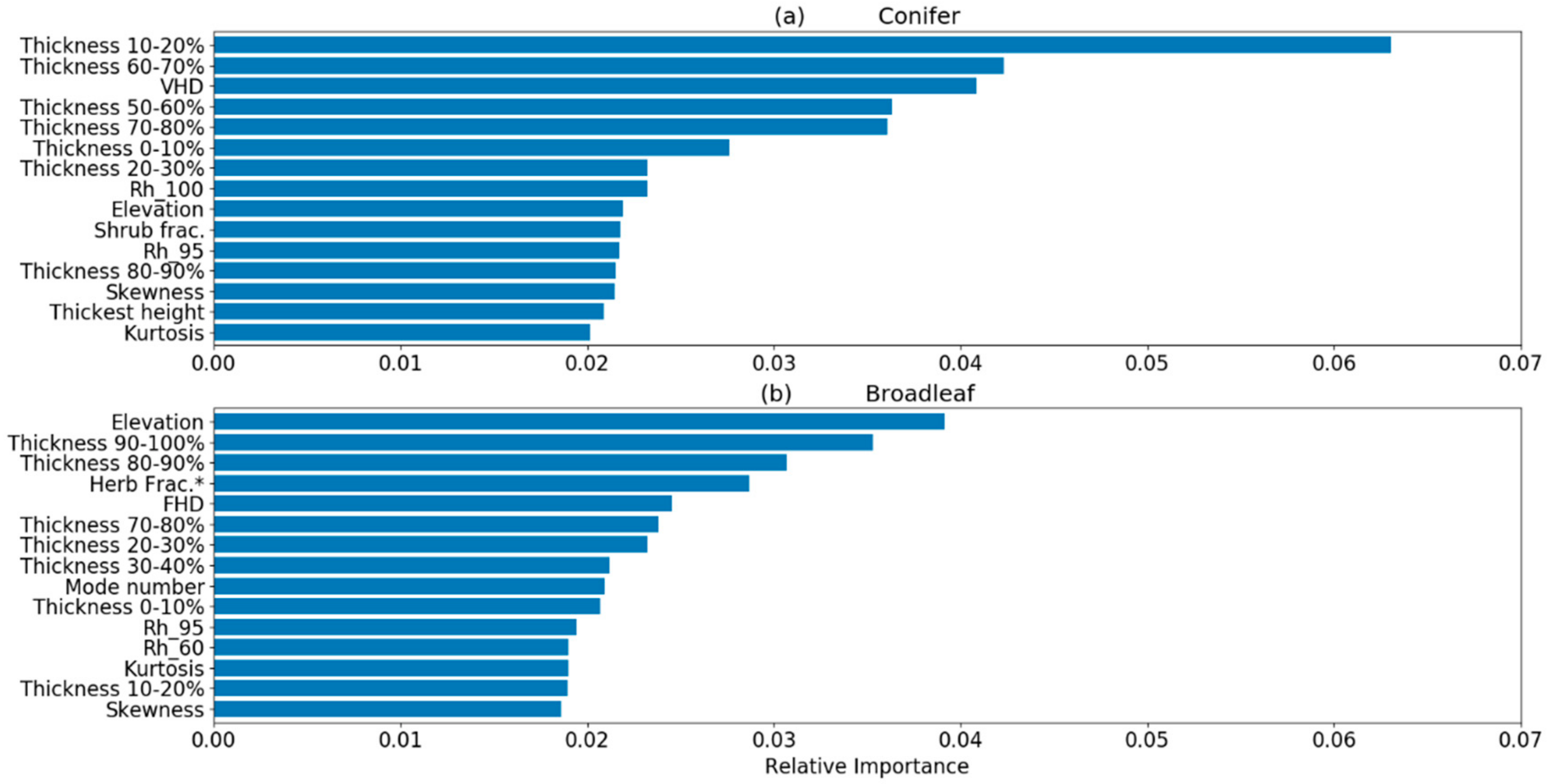
| Metrics | GEDI Source | Description |
|---|---|---|
| rhx | L2A | Relative height values x = 0,10,20,25,30,40,50,60,70,80,90,95,100 |
| Thickest canopy | L2A | Height of thickest canopy as fraction of canopy height rh100 |
| Thicknessx | L2A | Canopy thickness curve: % above-ground energy reflected by 0–10,10–20…90–100% height strata |
| Herb | L2A | % above-ground energy reflected by herb layer (0–1 m) |
| Shrub | L2A | % above-ground energy reflected by shrub layer (1–5 m) |
| Kurtosis | L2A | Kurtosis of canopy thickness curve |
| Skewness | L2A | Skewness of canopy thickness curve |
| Mode Number | L2A | Number of detected modes in waveform |
| Vertical Height Distribution | L2A | Normalised difference of canopy height and aboveground return midpoint |
| Elevation | L2A | Elevation of ground (in m) above sea level |
| Total cover | L2B | % of ground covered by vertical projection of canopy |
| Plant area index | L2B | Total plant area index |
| Foliage Height Diversity | L2B | Foliage Height Diversity computed using 5 m vertical height bins |
| Ground return | L2B | Fraction of waveform ground component and sum of ground and canopy components |
| For All Canopy Heights | For Canopy Heights >25 m | |||||
|---|---|---|---|---|---|---|
| Mean ± (st. err.) | Mean ± (st. err.) | |||||
| Structure metric | OGF | NOGF | t-stat. | OGF | NOGF | t-stat |
| rh100 (m) | 27.8 (0.1) | 27.5 (0.1) | 1.86 n.s. | 34 (0.1) | 32.7 (0.1) | 10.7 *** |
| Ground return (%) | 37.2 (0.3) | 25.8 (0.2) | 31.4 *** | 29.9 (0.4) | 19.6 (0.2) | 26.1 *** |
| Canopy cover (%) | 54.8 (0.3) | 67.3 (0.3) | −31.8 *** | 62.5 (0.4) | 74.1 (0.3) | −25.9 *** |
| PAI (m2 m−2) | 1.95 (0.02) | 2.71 (0.02) | −29.5 *** | 2.4 (0.03) | 3.13 (0.02) | −21.5 *** |
| FHD (m2 m−2) | 3.04 (0.004) | 3.04 (0.004) | −0.28 n.s. | 3.21 (0.002) | 3.21 (0.002) | 1.9 n.s. |
| VHD | 0.59 (0.002) | 0.47 (0.002) | 49.4 *** | 0.56 (0.003) | 0.42 (0.002) | 44.4 *** |
| Thickest layer | 0.24 (0.004) | 0.43 (0.003) | −39.4 *** | 0.27 (0.005) | 0.49 (0.004) | −32.6 *** |
| Mode number | 3.28 (0.02) | 2.89 (0.01) | 16.8 *** | 3.84 (0.03) | 3.14 0.02) | 21.3 *** |
| Herb layer (%) | 7.8 (0.1) | 5.7 (0.1) | 25.1 *** | 6.1 (0.1) | 4.5 (0.1) | 18.3 *** |
| Shrub layer (%) | 22.3 (0.2) | 15.8 (0.1) | 30 *** | 17.1 (0.2) | 10.4 (0.1) | 36.1 *** |
| For All Canopy Heights | For Canopy Heights >25 m | ||||||
|---|---|---|---|---|---|---|---|
| Mean ± (st. err.) | Mean ± (st. err.) | ||||||
| Structure metric | OGF | NOGF | t-stat. | OGF | NOGF | t-test | |
| rh100 (m) | 29.9 (0.1) | 27.5 (0.1) | 13.5 *** | 36.4 (0.1) | 36.3 (0.1) | 0.8 n.s. | |
| Ground return (%) | 22.6 (0.2) | 25.6 (0.3) | −7.8 *** | 14.2 (0.2) | 13.1 (0.2) | 3.5 *** | |
| Canopy cover (%) | 71.6 (0.3) | 68.6 (0.3) | 7.2 *** | 81 (0.2) | 82.5 (0.3) | −3.9 *** | |
| PAI (m2 m−2) | 3.27 (0.02) | 3.21 (0.02) | 2 * | 4 (0.03) | 4.23 (0.03) | −5.9 *** | |
| FHD (m2 m−2) | 3.06 (0.003) | 2.94 (0.005) | 20.2 *** | 3.24 (0.001) | 3.2 (0.002) | 16.8 *** | |
| VHD | 0.49 (0.001) | 0.48 (0.002) | 2.6 * | 0.44 (0.002) | 0.39 (0.002) | 17.1 *** | |
| Thickest layer | 0.49 (0.003) | 0.47 (0.003) | 4.3 *** | 0.56 (0.004) | 0.59 (0.004) | −5 *** | |
| Mode number | 3.58 (0.02) | 2.86 (0.02) | 30.9 *** | 4.1 (0.02) | 3.3 (0.02) | 25.7 *** | |
| Herb layer (%) | 4.2 (0.1) | 4.9 (0.1) | −10.3 *** | 2.7 (0.03) | 2.7 (0.05) | −1 n.s. | |
| Shrub layer (%) | 14.4 (0.1) | 16.9 (0.2) | −10.9 *** | 8.4 (0.1) | 7.4 (0.1) | 7.5 *** | |
| (a) Individual GEDI Shots Confusion Matrix | |||||
| ACTUAL | PREDICTED | ||||
| Classification | OGF | NOGF | Total | Prod.’s (%) | |
| OGF | 2944 | 1084 | 4028 | 73.1 | |
| NOGF | 1277 | 2867 | 4144 | 69.2 | |
| Total | 4221 | 3951 | 8172 | ||
| User’s (%) | 69.7 | 72.6 | |||
| Overall accuracy (%) | 71.1 | ||||
| (b) Shapefile Confusion Matrix | |||||
| PREDICTED | |||||
| ACTUAL | Classification | OGF | NOGF | Total | Prod.’s (%) |
| OGF | 403 | 129 | 532 | 75.8 | |
| NOGF | 160 | 363 | 523 | 69.4 | |
| Total | 563 | 492 | 1055 | ||
| User’s (%) | 71.6 | 73.8 | |||
| Overall accuracy (%) | 72.6 | ||||
Publisher’s Note: MDPI stays neutral with regard to jurisdictional claims in published maps and institutional affiliations. |
© 2021 by the authors. Licensee MDPI, Basel, Switzerland. This article is an open access article distributed under the terms and conditions of the Creative Commons Attribution (CC BY) license (http://creativecommons.org/licenses/by/4.0/).
Share and Cite
Spracklen, B.; Spracklen, D.V. Determination of Structural Characteristics of Old-Growth Forest in Ukraine Using Spaceborne LiDAR. Remote Sens. 2021, 13, 1233. https://doi.org/10.3390/rs13071233
Spracklen B, Spracklen DV. Determination of Structural Characteristics of Old-Growth Forest in Ukraine Using Spaceborne LiDAR. Remote Sensing. 2021; 13(7):1233. https://doi.org/10.3390/rs13071233
Chicago/Turabian StyleSpracklen, Ben, and Dominick V. Spracklen. 2021. "Determination of Structural Characteristics of Old-Growth Forest in Ukraine Using Spaceborne LiDAR" Remote Sensing 13, no. 7: 1233. https://doi.org/10.3390/rs13071233
APA StyleSpracklen, B., & Spracklen, D. V. (2021). Determination of Structural Characteristics of Old-Growth Forest in Ukraine Using Spaceborne LiDAR. Remote Sensing, 13(7), 1233. https://doi.org/10.3390/rs13071233




